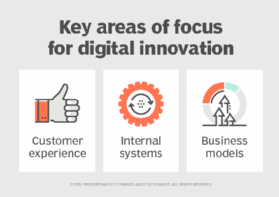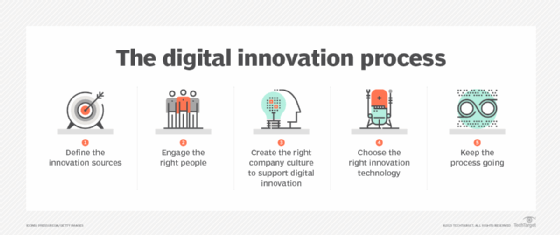digital innovation
What is digital innovation?
Digital innovation is the adoption of modern digital technologies by a business. This process is implemented as a strategic plan for organizations to improve business processes. Digital innovation also improves customer experience and performance and can be used to create new business models.
The goal of digital innovation is to use new technologies to improve processes and to create an advantage over competing businesses.

Digital innovation is a continuous effort in which organizations adopt new technologies and resources to create opportunities or to grow their business. This could include adopting artificial intelligence (AI) or machine learning processes to optimize pattern recognition in data or when implementing cloud services. The process promotes the open-mindedness needed to look for and adopt newer technologies that could prove beneficial to a business.
Why is digital innovation important?
Organizations that fail to follow or adopt emerging technology standards run the risk of becoming irrelevant. For example, Blockbuster's failure to capitalize on video streaming when competing with the new arrival of Netflix is what many cite as the reason behind its downfall as a company.
Other benefits of digital innovation include the following:
- Competitive differentiation. Just as organizations that fail to adopt new technologies risk irrelevancy, organizations that encourage digital innovation might be able to differentiate themselves from their competition.
- Improved business processes. Organizations that adopt new technologies to improve business processes, workflows and operational efficiency can reduce the time and resources that might otherwise be required.
- Improved customer experience. Organizations that adopt new technologies such as AI-enabled chatbots for their users can improve the overall customer experience.
- Improved data capabilities. Organizations that adopt new technologies to handle their data can improve the speed at which they process gathered data.
- Continual improvement. Digital innovation is a continuous process that promotes flexibility in adopting new technologies. Even after adopting a new technology, an organization should continue to search for other areas where they can adopt digital innovation.
How does digital innovation compare to digital transformation?
Digital innovation and digital transformation are similar concepts, but where digital innovation focuses on adopting new technology, digital transformation incorporates computer-based technologies into an organization's products, processes and business strategy.
This article is part of
What is digital transformation? Everything you need to know
Digital innovation often happens prior to a digital transformation. Even though it's an ongoing process, the adoption of new technologies in digital innovation is normally experienced as a sudden change. Comparatively, digital transformation is experienced as a longer process with a further reaching change to the organization. Digital innovation initiatives are also typically smaller in scale when compared to those for digital transformation.
Risks of digital innovation
The biggest risk of digital innovation is failing to implement a new technology fully, which can lead to large-scale monetary losses for an organization. This could be due to any number of reasons, including the following:
- Application of the wrong technology.
- Failing to commit to using the new technology.
- Failing to modify internal processes to adapt to new standard requirements.
- Failing to scale the new adoption.
- Not doing enough initial research on the technology.
- Underestimating the costs involved to fully implement the new innovation.
Reasons to encourage digital innovation
If encouraged in an organization, digital innovation can provide the following benefits:
- Create a better customer experience. Staying current with technological advancements while focusing on customer experience helps an organization meet customer expectations. For example, automating customer processes can improve efficiency and speed, improving the service and overall experience for customers.
- Improve productivity. Adopting process-centric technologies such as AI and machine learning can help automate and simplify tasks.
- Keep an organization from becoming irrelevant. Adopting new technologies ensures an organization can stay ahead of the curve and not fall behind competitor offerings.
- Offer a competitive advantage. Digital innovation can create new revenue streams and streamline internal processes.
How to create a digital innovation strategy
A digital innovation strategy should roughly follow these steps:
- Define the innovation sources. An organization should be able to define what it wants to address. This might include focusing on process or customer experience, or what differentiates the organization from other businesses and what its goals are for adopting a digital innovation strategy.
- Engage the right people. Senior executives can be involved in the process, as well as dedicated digital innovation roles such as a chief innovation officer or a corporate innovation board. IT teams and other employees within the organization can help incorporate new technologies or the work can be outsourced.
- Foster a company culture that supports digital innovation. Adopting new technology is sometimes a hurdle for digital innovation. An organization's employees should be ready to adopt new tools and processes.
- Choose the right technology. An organization should be able to adopt and use the technology being implemented as intended. The technology should also be scalable to all applicable employees. If not, then the organization could waste time and money implementing a technology it can't handle.
- Keep the process going. Digital innovation is a continuous and changing process, so organizations should keep an open mind and be flexible to more potential technical innovations. Any efforts should be evaluated and adjusted.

Examples of successful digital innovation
The following are examples of digital innovation:
- Domino's. The Domino's pizza chain implemented a digital innovation strategy that enabled customers to place orders on mobile apps such as Meta's Facebook Messenger, X (formerly Twitter), Slack or through the Alexa voice assistant.
- Disney. When social distancing measures due to the COVID-19 pandemic began, attendance at movie theaters dropped and content consumption through streaming services increased. To stay relevant and to accommodate its customers, Disney developed its own online streaming platform.
- Porsche. Porsche extended its digital innovation strategy throughout the company. For example, one Porsche digital innovation project is to expand the automation of its vehicles' autopilot mode. Porsche also embraces the concept of digital innovation in the Porsche Data Cup, where developer teams from different companies take part in a digital innovation competition.
Learn about the challenges involved in creating a culture of innovation, such as gauging an organization's readiness to accept risk and establishing guardrails.






